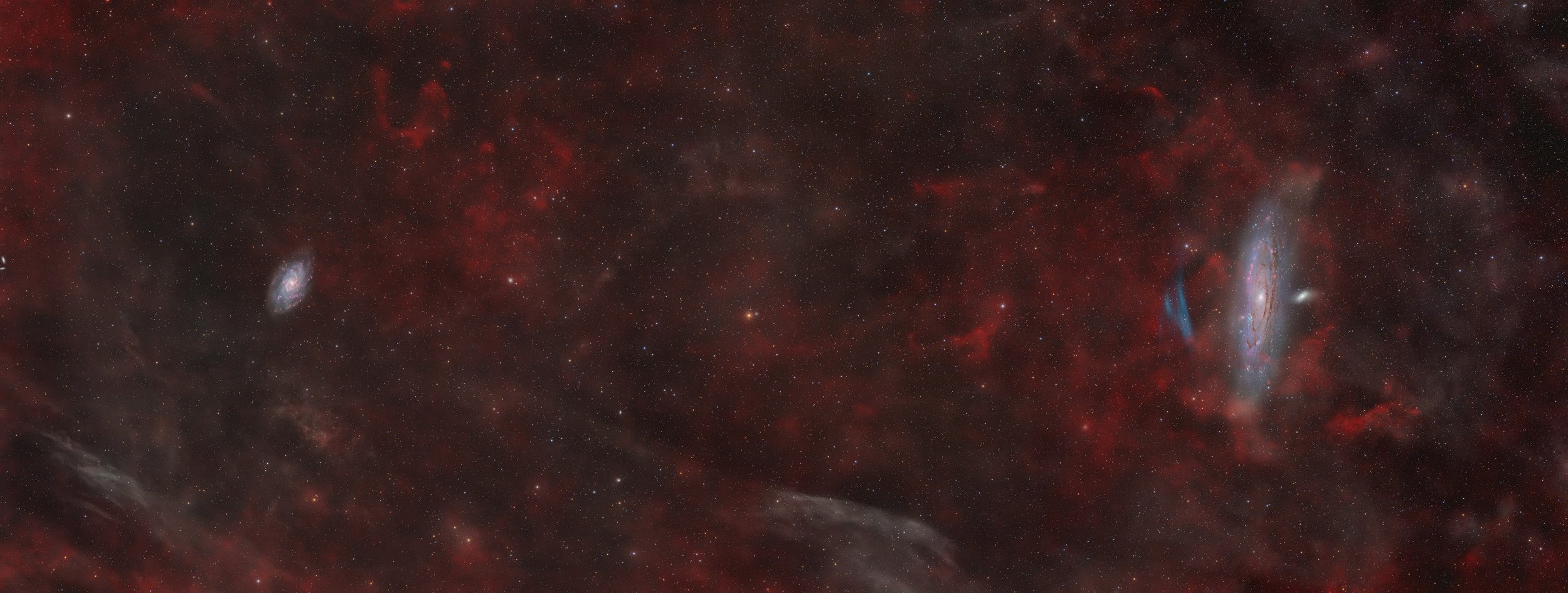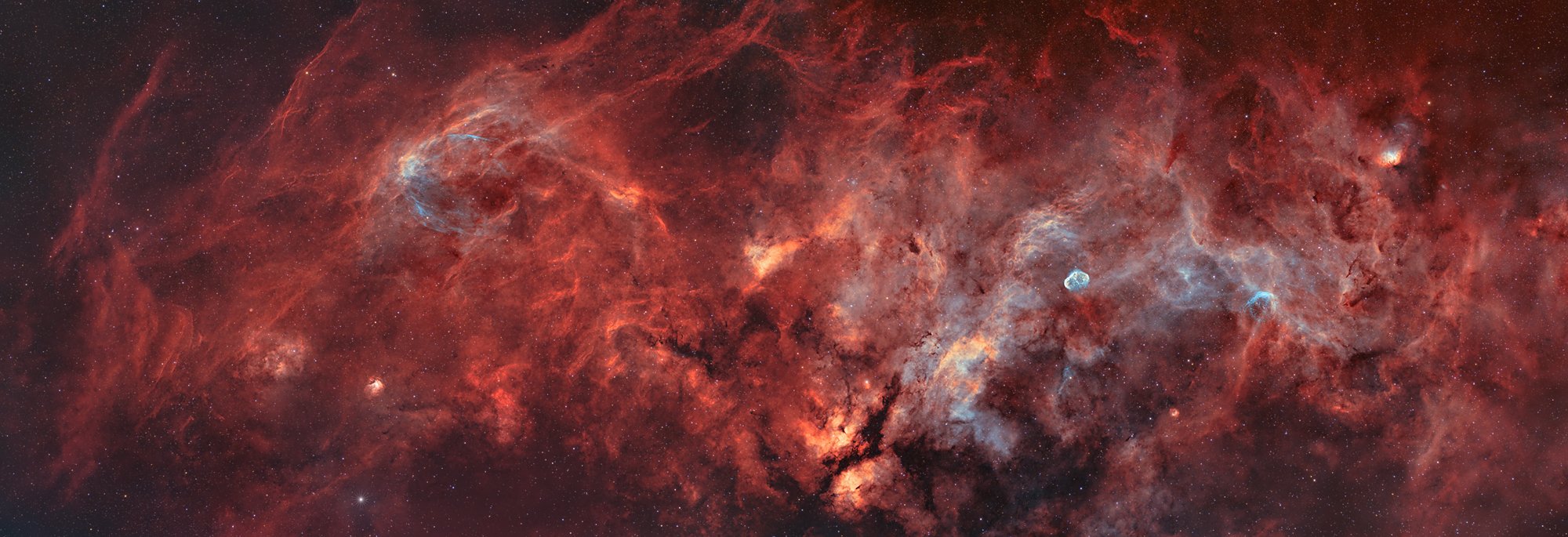
AAPOD2 Image Archives
Yann Sainty
Featured Astrophotographer on AAPOD2
NGC 7094 and its new feature
This wide-field view reveals an extraordinary blend of cosmic objects, each contributing to the visual and scientific richness of the image.
M15, one of the densest globular clusters in the Milky Way, glitters with the light of hundreds of thousands of stars tightly packed into a spherical shape. Located about 33,000 light-years away, its dense core may harbor a rare intermediate-mass black hole, making it a subject of ongoing research.
NGC 7094, a planetary nebula, is a stellar remnant left behind by a Sun-like star nearing the end of its life. Its central white dwarf illuminates the nebula with ultraviolet radiation, sculpting the surrounding gases into intricate shapes.
The [O III] Zone, an unexpected discovery in this image, spans a large region and glows with a faint greenish-blue hue, characteristic of doubly ionized oxygen. The nature of this halo is a mystery—potentially a remnant of ancient stellar outflows or interstellar shockwaves.
Adding to the beauty, the image is interlaced with crimson hydrogen-alpha emissions and cosmic dust clouds, which create a vivid backdrop. These elements highlight the interplay of old and new: ancient star clusters, dying stars, and the raw materials for future stellar generations.
This image serves as a testament to the power of wide-field astrophotography, revealing not only familiar objects but also uncovering hidden phenomena awaiting deeper exploration. It’s a reminder that even well-known regions of the sky still hold secrets to be discovered.
LDN204 and his dusty friends
This mosaic of LDN 204, composed of three tiles, captures the intricate beauty of the sky background, bringing together all the Hα emissions and dust in the field. The detailed observation offers a unique view of the complex interplay between hydrogen-alpha regions and interstellar dust.
Each tile in the mosaic reveals the rich structure of LDN 204, highlighting the delicate filaments and wisps of cosmic dust. The high-resolution images provide valuable data for astronomers, allowing for an enhanced understanding of the field's complex structure and contributing to our knowledge of the interstellar medium. This comprehensive approach not only showcases the nebula but also enriches our appreciation of the cosmic environment it inhabits.
ATLAS - the unexpected Supernova Remnant G209.8-8.2 in Orion
Supernova Remnant G209.8-8.2, nestled within the sprawling constellation of Orion, stands as a testament to the cataclysmic events that shape the cosmos. Born from the explosive death of a massive star, this remnant carries the echoes of a stellar demise, scattering its remnants across the cosmic landscape. As the shockwave from the supernova blast continues to propagate through space, it interacts with the surrounding interstellar medium, creating intricate patterns of gas and dust that trace the remnants of the progenitor star.
Spanning across vast expanses of space, Supernova Remnant G209.8-8.2 offers astronomers a glimpse into the turbulent aftermath of a supernova explosion. Its intricate structure, shaped by the forces of stellar winds and interstellar dynamics, provides valuable insights into the life cycle of stars and the processes that govern the evolution of galaxies. Studying this remnant allows scientists to unravel the mysteries of stellar explosions, shedding light on the origins of heavy elements and the energetic phenomena that shape the universe. As it graces the night sky with its celestial presence, Supernova Remnant G209.8-8.2 stands as a reminder of the dynamic and ever-changing nature of the cosmos.
northern tip of the Monoceros constellation
In the vicinity of Dreyer's Nebula, also known as NGC 2264, lie several other notable celestial objects, including the Cone Nebula and the Christmas Tree Cluster. While Dreyer's Nebula itself is a reflection nebula illuminated by the star S Monocerotis, the Cone Nebula is an adjacent dark nebula that appears as a distinctive cone-shaped feature against the backdrop of interstellar space. Nearby, the Christmas Tree Cluster, or NGC 2264, is a young stellar cluster embedded within a diffuse emission nebula, adding to the visual richness of the region.
Though these objects may vary in size and appearance, they collectively contribute to the captivating beauty of the cosmic landscape in this part of the sky. Together, they offer astronomers and stargazers a glimpse into the dynamic processes of star formation and interstellar sculpting, showcasing the intricate interplay between stars, gas, and dust in the vast expanse of the universe.
Dolphin Head Nebula (Sh2-308) : A Morocco-Chile connection
Sh2-308 emerges as a stellar nursery, where a symphony of ionized gas and dust paints a celestial portrait against the backdrop of Aquila's cosmic expanse. The nebula's intriguing moniker, the Dolphin Head Nebula, stems from its distinct shape, which bears a resemblance to the playful form of a leaping dolphin against the canvas of the night sky.
The Dolphin Head Nebula comes to life through the brilliance of newborn stars illuminating the surrounding interstellar medium. The interplay of light and shadow within the nebula's intricate structure weaves a tale of stellar birth and the ongoing dance of cosmic forces.
Situated approximately 5,000 light-years away, Sh2-308 stands as a testament to the vast and dynamic nature of our galactic neighborhood. As observers gaze upon this celestial dolphin, they are reminded of the boundless creativity at play in the cosmos, where nature's artistry manifests in the intricate details of a nebular realm.
Supernova remnant G107.5-5.2. — the Nereides nebula in Cassiopeia
In this celestial masterpiece, we peer into the aftermath of stellar cataclysms through the lens of the cosmos. Supernova remnants, such as the captivating G107.5-5.2, bear witness to the explosive demise of massive stars, unleashing unimaginable energies that ripple through the fabric of space. These remnants, like ghostly echoes of celestial fireworks, exhibit intricate structures of ionized gas and dust, adorned with vibrant hues that tell the tale of elemental creation. Each remnant is a cosmic crucible, where the remnants of an exploded star mix and mingle, seeding the cosmos with the building blocks of new generations of celestial bodies. As we explore the remnants of these stellar explosions, we unravel the dynamic forces that shape our galactic landscape and gain a profound glimpse into the majestic cycles of stellar life and death.
From Triangulum to Andromeda
This captivating deep-space image spans a vast cosmic expanse from the Andromeda Galaxy (M31) to the smaller yet equally enchanting Triangulum Galaxy (M33). This astronomical composition is a mesmerizing blend of multi-spectrum imagery, seamlessly harmonizing hydrogen-alpha (Ha) and doubly ionized oxygen (OIII) emissions with luminance (L), red (R), green (G), and blue (B) channels. In this breathtaking capture, the fiery tendrils of Ha and the ethereal glow of OIII emissions intertwine with the intricate details of stars and dust, creating a celestial astro-photo that not only reveals the grandeur of these neighboring galaxies but also provides a glimpse into the intricate astrophysical processes shaping the universe.
The jewels of Cygnus
Within the expansive boundaries of the constellation Cygnus, two remarkable astrophotography targets beckon sky gazers. The Crescent Nebula (NGC 6888) unveils its ethereal beauty, emanating from the powerful stellar winds of its central Wolf-Rayet star. The nebula's distinctive shape resembles a delicate crescent, bathed in hues of magenta and blue. Its intricate filaments, sculpted by the star's intense radiation, paint a captivating celestial portrait.
4 dust monsters
During our stay at the observatory, I had a little bit left at the end of the night after our collaboration, so I took the opportunity to take a walk in this dusty area of the sky that had been watching me for a while. I was able to shoot it properly during this moonless weekend.
I really wanted to highlight this epic fight scene between 4 dust monsters, LDN 1228, LBN 550, LBN 552 and LBN 555, that's why I went with this diagonal framing to make it look like one takes over in this battle.
I also wanted to respect the natural colors which I find really beautiful and which accentuate this duality with the bluish and orange hues like ice and fire.
Shot on February 3, 27 and 28, 2022.
Takahashi FSQ106 EDX4 with 645-QE super reducer
Asi 2600MM Pro
Antlia LRGB filters
Eq6r-pro
Altaïr 60/225 guide + asi 290mm mini
L: 130x300''
R - G -B: 25x300'' per filter
Stars: 90x15'' per filter
Bortle sky 4
Acquired: N.I.N.A + Phd2
Processing: Siril + PixInsight + Photoshop
Copyright: Yann Sty
The Spaghetti Nebula -SIMEIS 147- SH2-240
Image Description and Details :
It took me 2 months to acquire enough lights to make anything out of it.
Indeed, I shot 14 winter nights between November and January (5 of which played with my nerves with the fog lifting at nightfall without being able to do anything).
So I shot from the Vosges, I camped in 0 ° C in Alsace, I shot from my astrobro Christope in Moselle, I went south of France to Valensole and I moved on several spots on several nights in this region.A total of 3,600 km of road to acquire the 55 hours of lights retained which consist of:
Tile 1:
Ha -> 71x600 ’’
Oiii -> 78x600 ’’
R G B -> 90x10 '' per filter
Tile 2:Ha -> 94x600 ’’
Oiii -> 78x600 ’’
R G B -> 90x10 '' per filter
While the acquisition was long and complex, so was the processing, I had to work with 400GB of data for a final image of 15 000 x 12 000px.Suffice to say that the PC has smoked!
Once again a big thanks to Christophe who illuminated me with his advices during the processing and gave me invaluable help, thanks also to Nico for his always correct eye!
Technical part:
Takahashi FSQ106 EDX4 with 645-QE super reducerAsi 2600MM Pro
Barilla (Antilla) RGB + H and O 3nm filters
Eq6r-pro
Altaïr 60/225 guide + asi 290mm mini
Sky bortle 3-4
Acquisition: N.I.N.A + Phd2
Processing: Siril + PixInsight + Photoshop
Taken in several parts of France between 2021/11/10 and 2022/01/03
Copyright : Yann SAINTY
Perseus Molecular Cloud
Image Description and Details : First "official" photo of our team Team Stellae Orientis Astrophotographie with the Perseus molecular cloud in LRGB by Yann SAINTY.
The Perseus molecular cloud contains the nebulae NGC1333 and IC348.
First lights on the fsq106 and the 2600MM and the result is up to my expectations. Combined with a bortle 4 sky this setup promises beautiful moments.
No moon so I wanted to image NGC1333 but seeing the beauty of IC348 next to it I could not resist the appeal of the mosaic despite the fact that it was not recommended during a first session with a new setup.
I imaged over 2 nights instead of 4 (lots of humidity and fog), which frustrates me in the sense that I only got half of the raws I wanted and so I had to shoot more processing. as desired, but you have to know how to have fun and try things!
Technic :
Takahashi FSQ106 EDX4 with 645-QE super reducer
Asi 2600MM Pro
LRGB Antilla Filters
Eq6r-pro
Altaïr 60/225 guide + asi 290mm mini
L: 45x300 '' per tile
R - V -B: 15x300 '' per filter per tile
Sky bortle 4
Acquisition: N.I.N.A + Phd2
Processing: Siril + PixInsight + Photoshop
From France
2021/10/07 & 2021/10/10
Copyright Yann SAINTY












